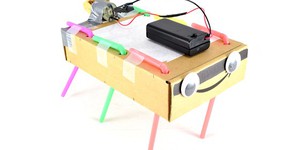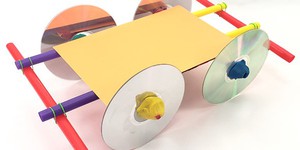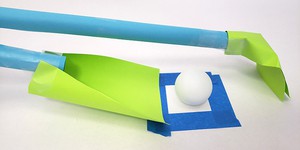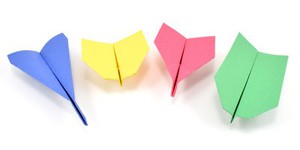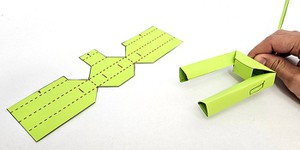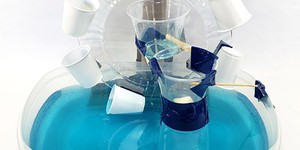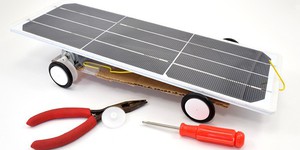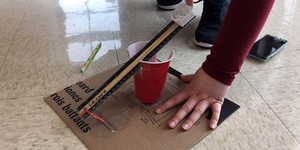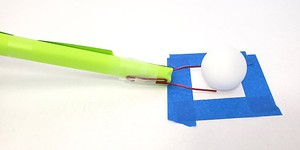Mechanical Engineering Lesson Plans (14 results)
If you're interested in object motion and enjoy building things or taking mechanical things apart to see how they work, then it sounds like you'd be interested in mechanical engineering.
|
Select a resource
Sort by
|
Lesson Plan
Grade: 6th-8th
21 reviews
Your students will design, build, and race balloon-powered cars in this fun lesson plan that teaches about engineering design and kinetic and potential energy.
Read more
NGSS Performance Expectations:
Featured
Lesson Plan
Grade: 6th-8th
7 reviews
Junkbots are easy-to-build robots that you can make using a simple circuit and some recyclable materials. In this lesson, your students will learn about engineering design as they compete to build the fastest robot. No previous robotics experience is required!
Read more
NGSS Performance Expectations:
Lesson Plan
Grade: 6th-8th
10 reviews
The egg drop project is a time-honored tradition in many science classrooms. Students build a device to protect an egg and prevent it from breaking when dropped. This project typically relates to lessons about Newton's laws of motion or potential and kinetic energy. However, it is also a great way for students to practice the engineering design process, and learn about the importance of design iteration and learning from failure.
Read more
NGSS Performance Expectations:
Lesson Plan
Grade: 6th-8th
4 reviews
Combine Newton's third law of motion with engineering design in one fun lesson! Your students will learn about equal and opposite reaction forces as they design and build a bumper to protect a toy car during a crash.
Read more
NGSS Performance Expectations:
Lesson Plan
Grade: 6th-8th
18 reviews
In this fun engineering lesson plan, your students will build devices from paper, tape, string, and paper clips to pick up and retrieve a ping pong ball. The challenge is to pick up the ball from as far away as possible!
Elementary school and
high school versions of this lesson plan are also available.
The 2023 competition is over, but you can see what students built and learn about the winners on the 2023 Engineering Challenge summary page.
Read more
NGSS Performance Expectations:
Lesson Plan
Grade: 3rd-5th
18 reviews
Are paper airplanes a nuisance in your classroom? They don't have to be! Those distractions can be a constructive learning opportunity: use them to teach your students about the engineering design process. In this fun lesson, you will be the "customer" ordering a paper airplane, and your student teams will be engineering companies that will manufacture planes. Before they start making planes, they need to define the criteria and constraints of this engineering problem.
Read more
NGSS Performance Expectations:
New
Lesson Plan
Grade: 6th-12th
Create a two-part system for filtering greywater. Teams will focus on communication and systems engineering as they build separate components to filter solid and liquid waste and then combine them into one device.
Learning Objectives
Students will:
Consider the potential effects of drought and how greywater could be part of the solution.
Design a system for filtering out solid waste or liquid waste.
Consider effective communication strategies with their team.
Collaborate on their design…
Read more
Lesson Plan
Grade: 6th-12th
1 review
When your students think of robots, they probably think of materials like metal or plastic—but what about paper? In this lesson plan, your students will learn to make robotic parts from readily available classroom materials. Optionally, they can apply the engineering design process to improve the design or come up with their own designs.
Read more
Lesson Plan
Grade: 4th-8th
2 reviews
What would your students do if your town's water supply was cut off due to an equipment failure or natural disaster? Inspired by
Global Problem Solvers: The Series,
in this lesson plan they will tackle a real-world engineering challenge by building a prototype of a device that can manually pump water during an emergency. They will also think like entrepreneurs and come up with a business plan for how their device could be produced, sold, and used in the real world.
This lesson is one of…
Read more
NGSS Performance Expectations:
Lesson Plan
Grade: 5th-8th
Help your students learn about solar energy, physical forces, and other science topics with this hands-on engineering experience. This lesson plan will show you how to get your classroom started building solar-powered cars that your students can enter, if desired, in regional Junior Solar Sprint competitions. No previous experience with electronics or building things is necessary.
Get the dates and location for your
regional competition.
Read more
NGSS Performance Expectations:
Lesson Plan
Grade: 6th-8th
2 reviews
Add a twist to a traditional "build a catapult" engineering project with this fun lesson plan based on the 2018 Engineering Challenge. Your students must build a device to launch a ball as far as possible—but they also have to build another device to catch it! With detailed rules and guidelines for a class-wide competition, this lesson is a great way to teach your students about the engineering design process.
Read more
NGSS Performance Expectations:
Lesson Plan
Grade: 3rd-5th
13 reviews
In this fun engineering lesson plan, your students will build devices from paper, tape, string, and paper clips to pick up and retrieve a ping pong ball. The challenge is to pick up the ball from as far away as possible! Middle school and
high school versions of this lesson plan are also available.
The 2023 competition is over, but you can see what students built and learn about the winners on the 2023 Engineering Challenge summary page.
Read more
NGSS Performance Expectations:
|
Explore Our Science Videos
How to Make Elephant Toothpaste
How to Build an ArtBot
How can air pressure prevent leaks?




